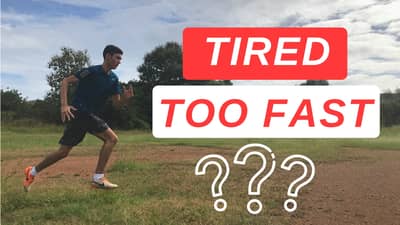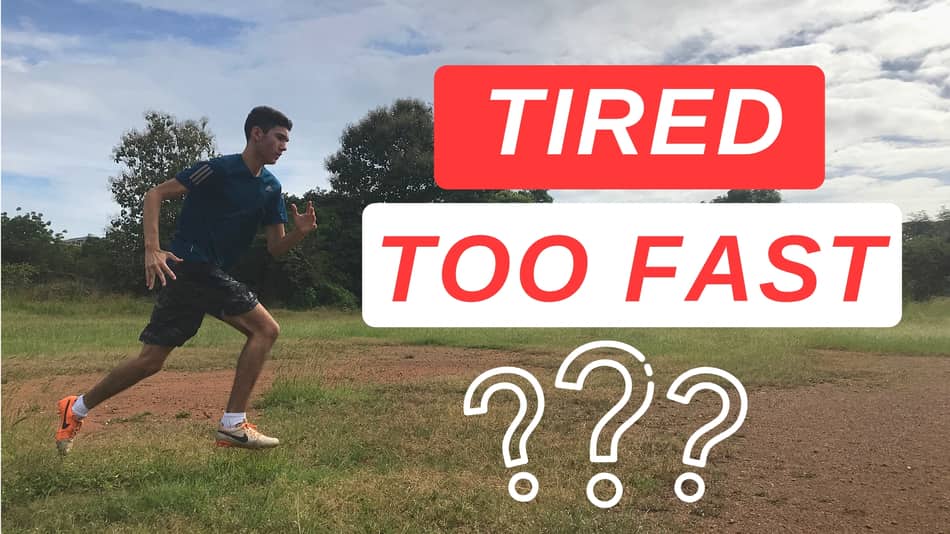
When I grew up and was about to turn 16, I realized that what makes soccer players different in a team is for how long they are capable of running and the level of stamina they have to perform at their best for the whole 90 minutes of the game. Before this, I didn’t give any importance to improving stamina, and I was being left behind. I needed to catch up and improve my endurance as quick as possible. Here’s what I did.
So, how can you improve stamina and endurance for soccer? Here are 4 of the most important things I did to do it:
- Training according to soccer: Jogs or straight-line runs are useless. You need to train by simulating real movements you would do in a game.
- Change your lifestyle: Good Nutrition and enough sleep are vital for any person that performs any sport.
- Know how stamina and endurance in your body work scientifically
- If you fool around at practice, don’t expect results in a game.
In this article we are looking at how you can improve your endurance in the fastest way possible. It is true that with most of the tips you will read here you’ll see great results in a month (or even less), but there are also other life hacks you can use to improve on things you are doing wrong right now that will help you have a better stamina instantly, at least a little bit.
Why is Stamina so Important?
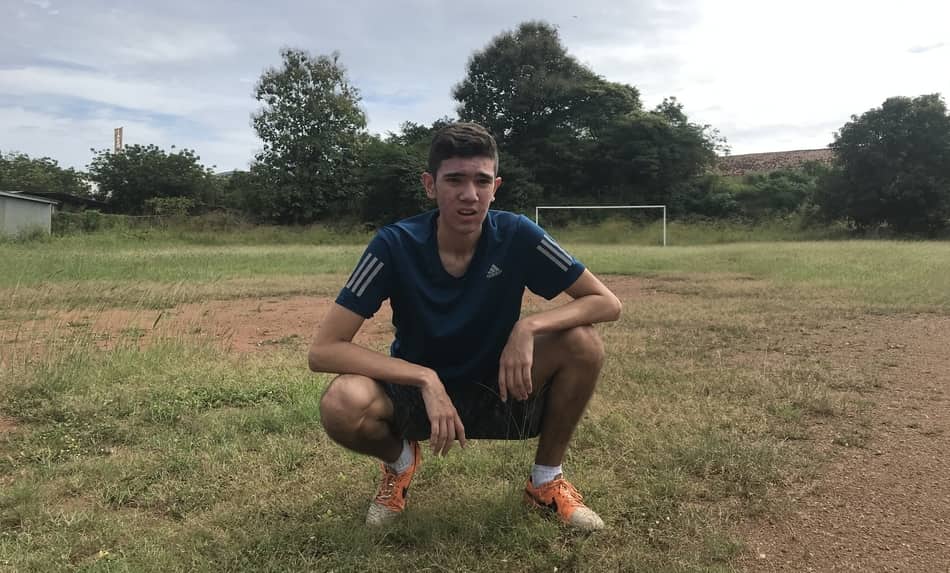
I’ve played many sports in my life and, in my opinion, soccer is one of the sports that demands the most physical conditions. You are constantly running up and down the field, defending against a player, moving to the space to receive and make passes. You are rarely just walking around the field. If you don’t build up stamina, after 10 minutes, you’ll end up like me in the image above.
The sport demands you to be very active. We’ve all played against or with players that just leave us astonished of how much they can run, that makes us think: “Damn, that guy is everywhere”. Great examples of players like this are: France’s Ngolo Kante, Germany’s Toni Kroos, and Croatia’s Luka Modric. All these players seem tireless in the field, but most importantly, are elite soccer players.
It is true that there is a lot more to soccer than just being able to run a lot and having great endurance. You’ve got to be smart and know where to move in order to be a great player. But, I think that we can all agree that stamina is a fundamental skill to be improve in every single soccer player.
Just by having more endurance than other soccer players you and your team have the following benefits:
- You are able to cover more space in the field, making it harder for the other team to score.
- You’ll usually win all those 50/50 balls. Winning those balls, means having majority of possession of the ball. Majority of possession means winning most of the games, which also means winning championships.
- You are able to have a clear mind to think correctly and take correct decisions in the game. When we are tired, we get to a point where we can’t think of ideas or are unable to execute them.
- By minute 80 of the game, both teams are very tired. If you have a great stamina, you use this to your advantage to step up your game.
The list can go on even further. The point is that you need to understand that playing soccer requires a lot of energy from your body. If your endurance is bad and you are running out of energy too fast, your are unable to do anything in the game, anything from running to even thinking will be more difficult.
Having a Soccer Training Program will be extremely helpful. However, you can’t do a training program for yourself, an expert should do it. I wrote an article about the The Best Soccer Training Program Online, which is the only Soccer Training Program that includes all the things I’ll talk about in this article. You should take a look at it.
Which Position Requires the Most Stamina?
First of all, you need to know that absolutely every position in the field requires a great level of endurance in every player. Even goalkeepers need to develop great endurance believe it or not. In my article “Most Skilled Soccer Positions”, I said that the most physically skilled position in the soccer field for me is full-back.
Full-backs are constantly running up and down the line. They have to defend, but also have to contribute in attack when possible. This is one of the positions that requires the most stamina. If you play in it, you should pay special attention to what you can learn in this article.
Training According to Soccer

It’s impressive the amount of teammates and coaches I’ve had in my life that think that the best method to improve stamina is jogging. I would say that jogging is a good exercise to warm up, but it’s not a drill you should use to improve stamina for multiple reasons.
#1 Reason is because it’s not related to the real movements we do in soccer. In a soccer game we are rarely just jogging in the field. We are constantly sprinting, making quick cuts, moving from one side to another, etc. Our movements are unpredictable, and from side to side, not in a straight line like when we jog.
In order to improve stamina for soccer we need to do more than just jogging for 2 miles a day. Not saying this can’t help, but if we want to achieve greater results we need to do something different that better simulates real in-game movements. The training method you get in the best training program I recommend will help you achieve that.
Aerobic vs Anaerobic
For you to understand this better you need to learn the difference between aerobic and anaerobic. These are two different type of exercises athletes make.
Aerobic exercise, as the word says, is exercise that requires air or oxygen. When we are not doing exercise, our body produces energy through a process called “cellular respiration”, that uses oxygen to produce energy for our muscles. Aerobic exercises are those that can be done through an extended period of time without us getting extremely tired.
This type of exercise is also known as “cardio”. Common examples of this exercise are: swimming, running, walking, hiking, etc. We can say that it’s an exercise made to improve stamina doing the same mechanism for long consecutive time.
In the other hand, anaerobic exercise, is the opposite, “without air”. Anaerobic exercise is any physical activity that requires you to quickly be out of breath, like sprinting or lifting heavy weights. This type of exercise is not meant to be done through extended periods of time. Any aerobic exercise that become too intense, can instantly become an anaerobic exercise.
What is Lactic Acid?
But, why do we say that it’s exercise “without air”? Because your body gets to a point where, no matter how much you breath, it can’t supply your muscles with enough oxygen to produce energy. That is why when we are making this exercises we feel like we are out of breath.
So, what your muscles do to produce energy is a process called “fermentation” (yes, that is the same thing that bakers use to make bread). The process basically burns sugars in your muscles and one of its products is something called “Lactic Acid”.
This acid is the reason why after an intense exercise you feel a burning sensation in your muscles. When we do anaerobic exercise, we are basically filling our muscles with this acid, making it impossible to keep training after some time.
Why is this important?
But, why is knowing all of these even important? Let me ask you a question: What type of exercise you think soccer is? Anaerobic right? That is why after every game we have a burning sensation in our legs, because they are filled with lactic acid. If we want to improve endurance FOR SOCCER then it makes absolutely no sense to keep doing aerobic exercise (like jogging or spinning at the gym) to improve it.
It’s true that aerobic exercise can also help you improve it, but what should represent the majority of your physical conditioning training should be anaerobic exercise.
The science behind endurance and stamina
Before getting into the exercises that you can do to help you improve your stamina, it is important that you know and understand how endurance and stamina work in your body. Why some people get tired quicker? What do you have to do to last longer running in a soccer game?
All of this are things you can answer by understanding how stamina scientifically works in the body. Don’t worry, I won’t use any tech, boring words that nobody can understand. It’s very easy to understand actually.
Remember that a problem you can’t understand is a problem that can’t be fixed. Also, what you can’t measure, you can’t improve.
VO2 max
VO2 max is simply the maximum capacity our body has to transport and use oxygen when we play soccer. The greater our VO2 max, the more oxygen we are able to use when exercising. As you read above, our body uses oxygen to create energy. The more oxygen the body can use, the more energy we will have, resulting in an improvement in endurance and stamina.
VO2 max is more related to aerobic exercise, meaning that after our body reaches its VO2 max we start to produce lactic acid. When our muscles accumulate too much of this acid we are unable to keep running in the field because of the burning and tired sensation.
One good reason why we should still make aerobic exercise as a soccer player is because it helps our body make its VO2 max higher, meaning that it will take more time for our body to get to the point where it starts producing lactic acid. Which means… yes, an increase in stamina. However, anaerobic exercise is still more important, and you’ll se why in the next point.
Lactate Threshold
The lactate threshold is the moment where lactic acid is building up in our muscles and we are not able to get rid of it. The moment we start a game, the muscles are building lactic acid already, but we are able to get rid of it quick because we are receiving enough oxygen and energy.
When we reach our lactate threshold it is a bad sign because that means that lactic acid is starting to accumulate in the muscles, until it reaches a point when the muscle is extremely tired and unable to perform. The higher the lactate threshold, the better stamina and endurance we’ll have in the soccer field.
So, how do we use all of this to improve our stamina? As you can see “VO2 max” is linked to aerobic exercise, while the “lactate threshold” is linked with anaerobic exercise. It is important that we increase the time our body takes to reach this points because it will determine the stamina and endurance we’ll have as a player. Here are some of the best exercises I’ve learned to increase stamina.
Creating Space and Routine for Stamina Workout (but be careful)
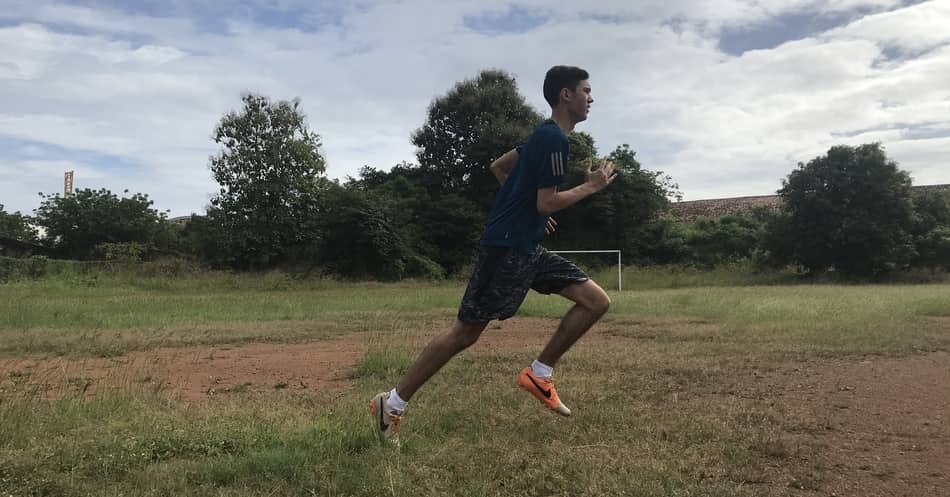
When I went to camp at the best high school soccer team in the United States, IMG Academy, I learned that physical conditioning exercise should last anywhere between 15 to 45 minutes, no more than that. Which is highly contradictory to what most soccer players are used to: jogging for an hour or making cardio exercise for as long as possible.
This makes sense considering what I explained above about aerobic and anaerobic exercise. In soccer it’s not about how long your endurance workouts are, but about how intense they are. In soccer, it’s always better to make a short very intense 30 minute workout that leaves you out of breath than just running for an hour.
Establish a daily routine that consists of making an intense stamina exercise for 45 minutes before your soccer training session and you’ll probably start seeing better results.
However, you need to be careful not to do the same exercise every single day. It is bad for two reasons. The first one being that our body gets used to an exercise after weeks, and second because by doing the same exercise you’re exposing the same muscles to overuse. Also, not varying between workout makes it a lot more boring. Always switch and make different routines.
Below, you’ll see some of the best exercises I consider that have helped me improve my stamina and endurance for soccer. You’ll see that they are short, intense, and simulate real in-game situation.
The Best Exercises for Stamina and Endurance
There are so many things you can possibly do to improve stamina for soccer. The best thing is that, in most of them, you don’t need to buy any type of expensive gear. The key in this is to get creative and use whatever you have near you. When your imagination has no limits, you will never run out of exercises you can do. Which is something great, because, as I said above, it is important to switch between exercises weekly so the body doesn’t get used to it.
You might have the exercises, but if you lose motivation it’s worthless. In my article The Key to Improve a Soccer by Yourself I give you some tips on how to avoid this and keep in track.
The following exercises are ones you can do with whatever you have within reach. Here are a couple of examples with pictures so you see that you don’t need to buy any type of gear.
Shuttle runs
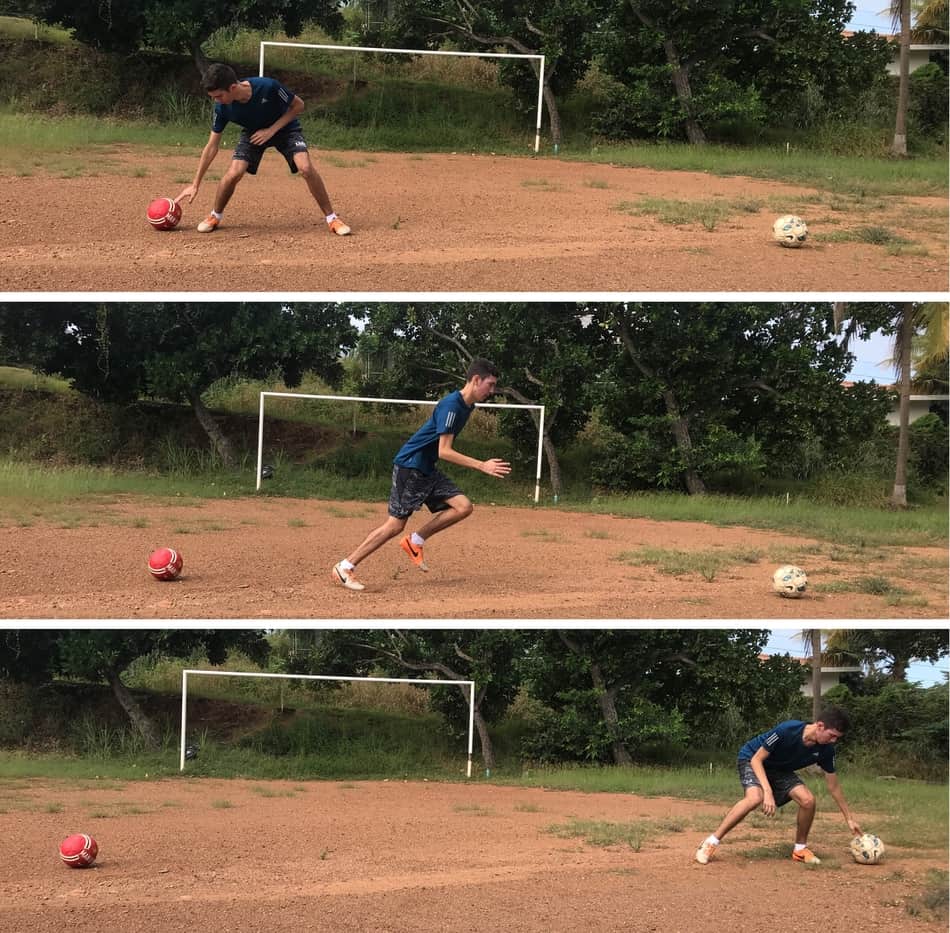
Shuttle runs are easily the most common exercise to improve stamina. Basically, they consists on doing a series of quick changes of directions using cones or anything you have to your reach.
The image you can see above is a simple exercise in which I run to one side, touch a ball, and then run to the other. You can do this with time (for 30 seconds) or by number of touches (5 touches of each ball). This exercise is super simple, you can add a third or fourth cone. You can also add other features, for example, making a quick 40 yard sprint forward or backward after completing the exercise.
You can also add a soccer ball, and have a person pass the ball to you, for you to pass it back every time you get to a cone (or any object you use). The key with this is to get creative and get the most out of the objects you have. In the internet you can find countless inspiration ideas for this type of exercise.
Stop and go sprinting
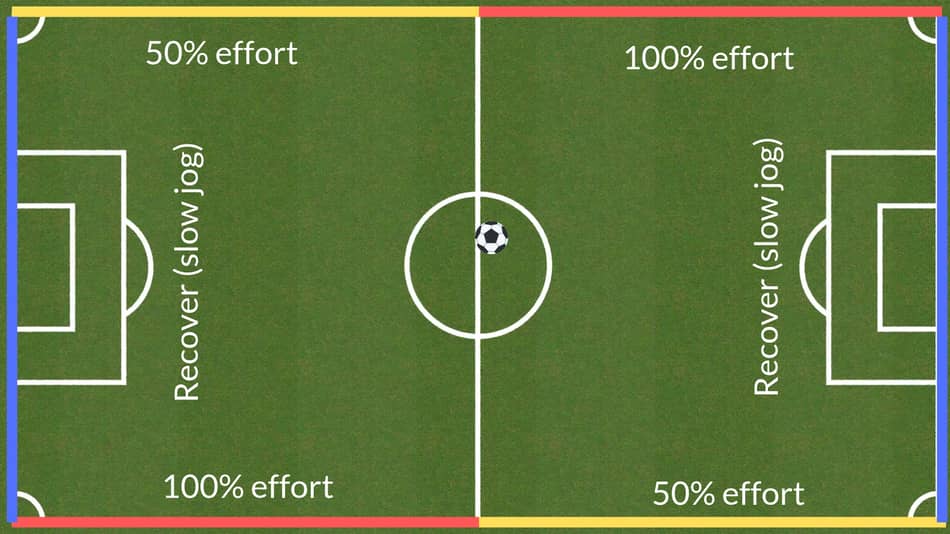
The image above can explain very well by itself. The idea is that you make sprints at an 100% effort in the red lines, then make a slightly lower jog at a 50% in the yellow lines. Then, making a slow jog to recover in the blue lines, but DON’T walk, keep jogging but at a pace you feel you can recover, to later do another 100% sprint again.
For me, this is the best exercise for endurance in soccer because it simulates what you are really doing in a soccer game. Sometimes you are sprinting, other times you are jus jogging, and other times you are recovering. It is important you do this exercise for 45 minutes without stopping at any moment. The reason why 45 minutes is great is because it’s the equivalent to one half of a soccer game.
Chest Jumps

In the image above you can see myself making what I call chest jumps. You simply jump and bring your knees to the height of your chest. Some tips to do this exercise:
- The moment you touch the ground, immediately you have to jump up again. Make it intense.
- Normally, people do small jumps and don’t lift their knees high enough. Jump high, and lift up your knees like in the picture.
- Make it intense and fast. Try doing it for one minute or 40 jumps.
This exercise is great when you are playing a game at practice. Every time one team scores a goal the other team’s players have to make 40 of these as a punishment.
Stairs and ladders
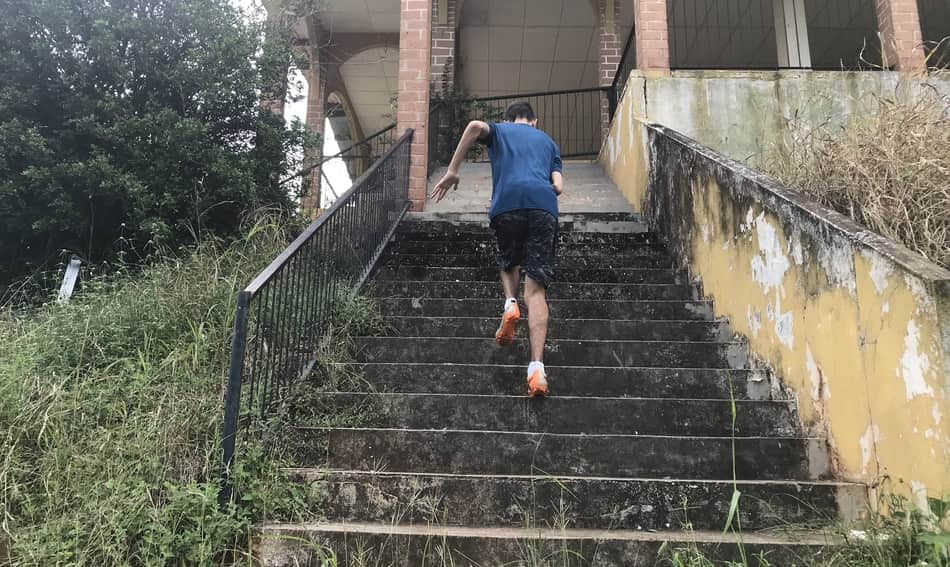
Stairs are everywhere. Try making as many different exercises on them as you can. In the image you can see I’m just running up the stairs as fast as I can. This is great because it not only improves stamina, but also improve feet agility.
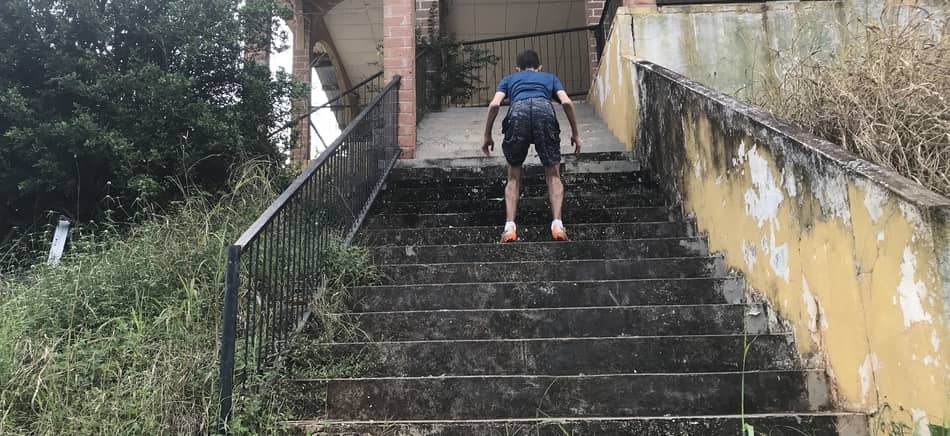
You can also try variations to the exercise. One great variations is climbing the stairs, jumping two to three steps at a time. The moment your feet touch the ground you have to jump again. Remember to always make these exercises with intensity. This will help you improve your endurance and your vertical jump.
One great tool I like to use to train stamina is an agility ladder (click to see one in amazon). You can do multiple exercises that simulate how we truly play soccer and that will help you have quicker feet and more endurance.
Running up a hill
Again, we are using things and places we would normally find near us. When running up hill, make sure to take few to zero rest between exercise. Make sure to make it intense as well as the ones above. It’s not how much time we do this, but how hard and powerful. Soon, you’re body will get used to it, and it will give you a great advantage when you run in a flat surface again.
Proper Sleep and Nutrition
This is the most obvious thing in life, but I still had to mention it. Proper sleep and nutrition is what gives fuel to our body. The better you fuel your body, the better it will perform.
This is one of the things that most people are doing wrong and they don’t even know it. I started eating great meals with rice, beans, protein, and salad, 3 to 2 hours before practice. That simple change in my nutrition made me feel like my stamina when playing soccer doubled. The reason why some days I felt tireless in the field and others not, depends on what I ate hours before the game.
Considering it is very hard to make a nutrition plan by our own, I think the Nutrition module of The Best Soccer Training Program online I recommend might be useful for you.
Life Hacks for Improving Endurance
The following tips are curious facts that scientist have proofed that can instantly improve stamina. I’ve tried some of them, the rest I’m very curious to find out if they actually work.
#1 Cold Bottle
The American Heart Association found out that keeping your hands cold while training boosts your endurance. Simply hold a cold water bottle when working out. This helps regulate your body temperature more efficiently for some reason.
#2 Some Candy before a Game
I’ve seen many players in many sports practice this technique. The one I remember that ate a bag of skittles as a ritual before playing was american football star Marshawn Lynch. He said that the sugar in the candy gave him enough energy to explode in the game. Also, I’ve seen players that like drinking red bull before a match, although I wouldn’t recommend this at all.
I’ve tried by myself to eat candy before a game to see if it does any difference. I have to say that I actually feel a little bit more hyped when playing but nothing that is an extreme-changer.
#3 Granola Bars and great hydration
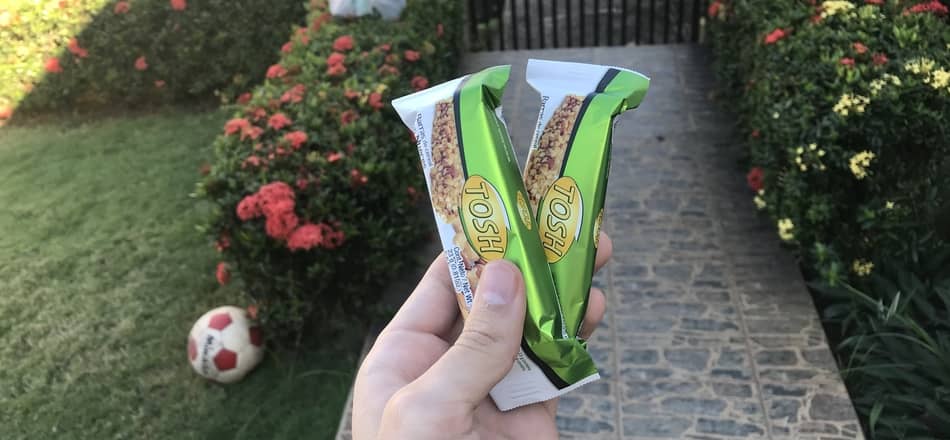
This is a technique I use to boost energy in practice or at games. I would usually put in my bag two granola or energy bars like the ones you see in the picture. I will eat at the middle of soccer practice or at halftime if it’s a game. They give me energy to keep going and help trick my stomach to make it feel like it’s full.
Also, I will usually take gatorade, powerade, and a lot of water. The best thing about this drinks is that it truly helps you re-fuel the body to give you an extra mile in a natural and more healthy way.
#4 Onions
This a tip I learned when researching for this article. People say that making onions part of your diet before you play will help improve stamina. Onions have a nutrient called “quercetin” that boosts blood flow, resulting in a better delivery of oxygen.
#5 Hard Glutes
There is a strange believe in the sports world that women are the only ones that have to workout glutes because it makes them look better ,and so on. I was one of those guys who didn’t workout glutes at all, and I paid the price for it when I got a glute injury that left me out of the fields for 3 months.
It was then when I realized that glutes are one of the most important muscles in the lower limb. They give us the power and ability to make quick cuts, changes of direction, and sprints. Overall, stronger glutes means more stability, better running technique, resulting in more endurance.
A great tip you can use in game is that, when you are tired, tense your glutes for an instant boost in running. Surely, it is useful if you are tired and being left behind by a defender.
#6 Low oxygen mask
Remember VO2? Well, the best way to improve your VO2 and your stamina is by using one of this Low-oxygen training mask like this one in amazon.
I truly believe this is one of the best tools out there to help you improve your stamina. It is a mask that regulates the amount of oxygen you can breathe. You can scale to many levels how limited air you want to receive. According to the journal of sports science and medicine, this helps increase VO2 max by 13% (the capacity your body has to transport oxygen).
Because you receive less oxygen, your body has to improve the way it uses the little it has. When you take off the mask, and breath the normal amount of oxygen any person without the mask would breath, you’ll have an advantage because your body is used to training with less oxygen than that.
#7 Train in altitude
If you have the chance to train in places that have a great altitude, you’ll realize that when you compete against teams at the sea level its like you had two extra lungs. It is no secret that teams in South America like Argentina or Brazil have a hard time every time they play Bolivia at “La Paz”, because of the altitude.
But, why does this happen? Because altitude training causes an increase in haemoglobin (molecules that carry oxygen to the muscles), so when athletes compete at sea level they are more efficient at transporting oxygen to their muscles. Or, in other words, there is less oxygen in the altitude. The training mask also helps you simulate this effect.
Breathing correctly
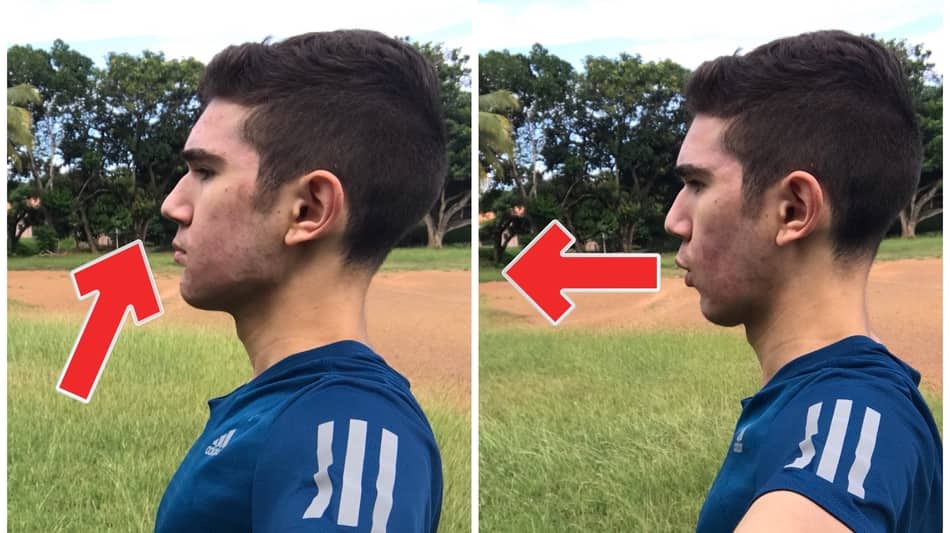
As I said before, it is super important for our body to receive as much oxygen as possible. The thing is that if we don’t breathe correctly, we are not getting the maximum amount of oxygen possible.
We all know the correct breathing technique: inhale from your nose, exhale from the mouth. However, we don’t breathe correctly when play, limiting the amount of oxygen we receive. Just by paying attention to how we breathe we make a huge difference and can improve our stamina. This can also help us recover quicker when we are tired.
Improving Running Technique
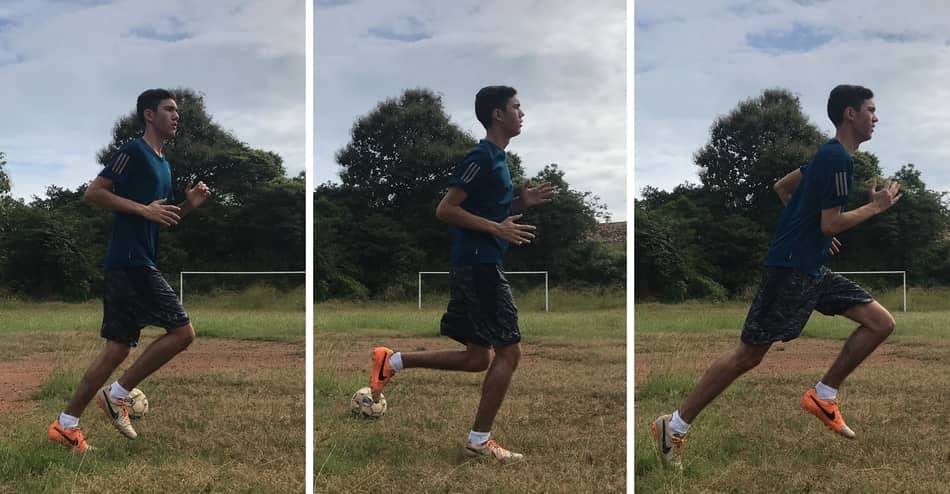
Another factor that seriously affect our endurance is our running technique. In the image above you can see a proper running mechanism. Some characteristics you should take into consideration are:
- Straight hands and marked arm movement. Arm movement should always be at a 90 degree angle and not across the body.
- You should always land in the balls of your feet. Not with your heel.
- Chest up.
- Upper body ahead of your lower limb.
A proper running technique helps you conserve as much energy inside the system. Just by improving your running technique you can instantly improve your stamina and endurance.
Running technique is so important that it is one of the things olympic runners practice the most. I found a course that can help you perfect this technique. Take a look at it clicking here to see if it is worth it for you.
Develop Mental Toughness
Stamina is not only physical. Our mind plays a huge role in our endurance. Most of the times, our mind will tell us that we can’t do it anymore even before we are actually done. We have to develop mental toughness in order to move forward and never stop, not only in soccer, but in every aspect of our lives.
Your mind will always want you to stop without giving your best effort. If you’re weak, you’ll probably end up loosing against her. Don’t stop when you’re tired, stop when the exercise is done.
Play as much as you can
Play as much as you can and you’ll see that you’ll get in shape very quick. You’re body will get used to the anaerobic exercise this game represents, and you’ll see that your overall levels of stamina will be benefited.
Try Practicing Different Sports
There are dozens of sports out there. Each one of them offers different benefits for our body. You can try to play other sports aside from soccer to acquire physical conditions that soccer can’t give you.
One great example is swimming. Swimming is easily one of the most complete sports out there, and can help us improve our physique in ways that soccer can’t. Going out for a swim once in a while would help a lot to improve your stamina.
Another sport I like to play a lot is basketball. Basketball has moments in which its even more intense than playing soccer. Learning from different sports and applying it to soccer not only makes you a better soccer player, but also a better athlete.

